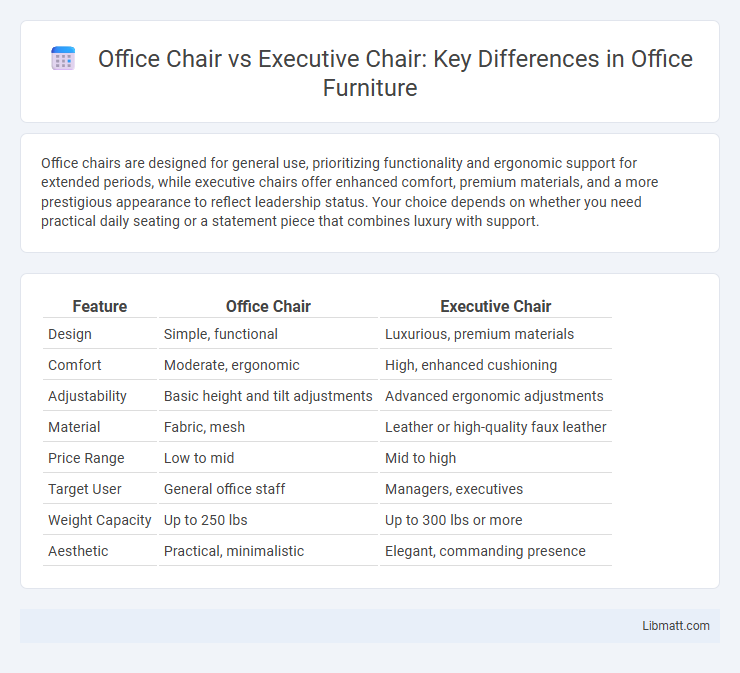Office chairs are designed for general use, prioritizing functionality and ergonomic support for extended periods, while executive chairs offer enhanced comfort, premium materials, and a more prestigious appearance to reflect leadership status. Your choice depends on whether you need practical daily seating or a statement piece that combines luxury with support.
Table of Comparison
| Feature | Office Chair | Executive Chair |
|---|---|---|
| Design | Simple, functional | Luxurious, premium materials |
| Comfort | Moderate, ergonomic | High, enhanced cushioning |
| Adjustability | Basic height and tilt adjustments | Advanced ergonomic adjustments |
| Material | Fabric, mesh | Leather or high-quality faux leather |
| Price Range | Low to mid | Mid to high |
| Target User | General office staff | Managers, executives |
| Weight Capacity | Up to 250 lbs | Up to 300 lbs or more |
| Aesthetic | Practical, minimalistic | Elegant, commanding presence |
Introduction to Office Chairs vs Executive Chairs
Office chairs are designed primarily for everyday use, offering ergonomic support and adjustability to enhance comfort during long work hours. Executive chairs feature a higher backrest, premium materials, and additional padding to provide superior comfort and a professional aesthetic suited for leadership roles. Choosing the right chair impacts your posture and productivity, making it essential to match the chair type with your workspace needs.
Key Differences Between Office and Executive Chairs
Office chairs prioritize ergonomic support and adjustability for prolonged daily use, featuring breathable materials and functional designs suitable for various work tasks. Executive chairs emphasize luxury and status, often constructed with high-quality leather, thicker padding, and a taller backrest for enhanced comfort and aesthetic appeal in managerial settings. The price range for executive chairs is generally higher due to premium materials and sophisticated design elements compared to standard office chairs.
Design and Aesthetic Comparison
Office chairs prioritize ergonomic design and functionality, often featuring mesh backs and adjustable components for improved comfort during extended use. Executive chairs emphasize luxury and status with high-quality leather upholstery, intricate stitching, and a more robust, cushioned structure that conveys professionalism. The aesthetic of executive chairs typically aligns with formal office decor, while office chairs favor a modern, minimalist look suitable for various work environments.
Ergonomics and Comfort Features
Executive chairs typically offer superior ergonomics and comfort features compared to standard office chairs, including enhanced lumbar support, premium cushioning, and adjustable armrests designed for prolonged use. Office chairs may provide basic ergonomic adjustments such as seat height and tilt control, but executive chairs often incorporate advanced mechanisms like synchronized recline and memory foam padding to support posture and reduce fatigue. Choosing an executive chair can significantly improve your comfort and productivity during long work hours.
Materials and Build Quality
Office chairs typically feature lightweight materials such as mesh or fabric upholstery combined with plastic or metal frames, designed for everyday use and moderate durability. Executive chairs prioritize premium materials like full-grain leather, high-density foam padding, and reinforced hardwood or polished metal frames to ensure superior comfort and long-lasting build quality. The construction of executive chairs often includes ergonomic enhancements and robust support elements that surpass the standard office chair's design.
Adjustability and Customization Options
Office chairs typically offer basic adjustability features such as seat height, tilt, and armrest adjustments to accommodate general workspace needs. Executive chairs provide enhanced customization options including lumbar support adjustments, seat depth variation, and multi-directional armrests, promoting superior ergonomic comfort for prolonged use. The advanced adjustability of executive chairs supports tailored posture alignment, reducing strain and increasing productivity.
Price Range and Value for Money
Office chairs typically range from $50 to $300, offering basic ergonomic features suitable for daily use at an affordable price. Executive chairs cost between $300 and $1,200, providing premium materials, advanced adjustability, and enhanced comfort, which justifies their higher price for long-term value. Evaluating the durability, ergonomic support, and build quality helps determine the best value for money based on individual needs and budget constraints.
Ideal Users and Office Environments
Office chairs are designed for general office workers who require ergonomic support for tasks involving long hours of sitting, suitable for standard cubicles, shared workspaces, and casual office settings. Executive chairs target senior management and executives, featuring premium materials and enhanced comfort, ideal for private offices and boardrooms where a professional and authoritative appearance is crucial. The choice between them depends on user needs for durability, status representation, and environment formality.
Pros and Cons of Office Chairs
Office chairs offer ergonomic designs with adjustable features that support long hours of work, promoting better posture and reducing back pain, while typically being more affordable and lighter than executive chairs. However, office chairs may lack the plush cushioning and high-end materials found in executive chairs, potentially sacrificing some comfort and style. Your choice depends on balancing budget, comfort, and the professional appearance desired in your workspace.
Pros and Cons of Executive Chairs
Executive chairs offer enhanced comfort with premium padding, ergonomic support, and adjustable features that promote better posture during extended work hours. However, their bulkier design and higher cost may not suit smaller office spaces or budget-conscious buyers. These chairs also tend to prioritize style and status, which might overshadow practical needs for some users.
office chair vs executive chair Infographic

 libmatt.com
libmatt.com